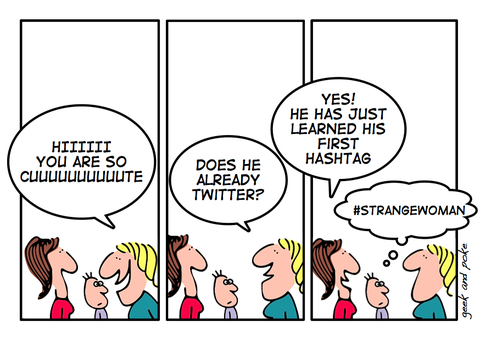Over the weekend, I noticed that Facebook hashtags are now linked. “What!? When did this happen??” I quickly asked my network.
This simple shift opens avenues for deeper discussions about the social media ecology of which I wrote a few weeks back. In particular, it shows the relational nature of the ecological system, and the back and forth multiply influential relationship between humans and technologies, all of which shape each other in a multiplicity of ways.
By social media ecology I refer to all of the media on and through which users are Social (in the capital “S,” linked and connected sense of the word introduced by Whitney Erin Boesel and Nathan Jurgenson). As social media increasingly integrates into the flow and logic of everyday life, users draw on a variety of digital tools to meet a diverse set of needs. The social media ecology refers to the set of tools users draw on, and the ways in which these tools, and their users, are connected and/or compartmentalized.
This social media ecology is deeply relational, in that each object (i.e., individual tool) is explicitly linked or separated from every other tool. The status of two objects as linked or unlinked (and their degree of linked-ness) is always a simultaneous product of both built in physical architectures (i.e., code) and human decisions. For instance, Twitter can be architecturally linked to Facebook, such that Tweets show up as status updates, but users must opt-in to this system. Similarly, one can import Facebook Friends to create Snapchat contacts, but does not need to find network members in this way (you can also import your phone contacts). On the other hand, one cannot link Twitter to Snapchat directly. However, one could potentially screenshot a Snap and Twitpic it to hir followers. In short, levels of integration between objects varies, and we would expect those objects with stronger links to take on more of one another’s characteristics. Twitter, Instagram, and Facebook, though distinct objects and quite different in several respects, are highly integrated through linkable content, similarity of layout, and (relatively) similar user bases—along with actual shared ownership in the case of Facebook and Instagram. It is therefore unsurprising that the practice of hashtagging—originating on Twitter and continuing on instagram—has seeped into the Facebook dialect.
This brings me to my second point: technologies and humans—especially those connected in an ecological relationship—work to shape one another both architecturally and normatively. The hashtag story goes like this: Twitter uses hashtags to categorize conversation threads, linking all Tweets with a shared hashtag to each other; Instagram (owned by Facebook) also uses hashtags to categorize images, linking all images with a shared hashtag to each other; The logic of hashtags bleeds into other spaces, as people start categorizing written, oral, and visual statements with hashtags on both Facebook and in informal conversation (FtF, SMS, e-mail etc.); Fast forward several years, and Facebook alters its code to link Facebook posts with shared hashtags with each other, architecturally establishing a Twitter-style practice in which Facebook users were already normatively engaged. What this means, is that the technological setup of Twitter—a medium with fast growing popularity and mainstream usage—altered 1) general linguistic practices; 2) user practices on a second technological object (Facebook); and 3) the architectural setup of this second technological object.
The spread from Twitter and Instagram to Facebook is significant, not only in that the practice is now embedded within multiple sites of the ecology, but also because Facebook is such a strongly integrated ecological point. The use of hashtags in discourse is growing, and creating a particular kind of discursive grammar, one in which primary text garners meaning through its location in categorical schemas. How this affects the logic of thought and speech more generally continues to evolve. As with all patterns of language, however, the true effects sneak in largely unnoticed, providing fodder for future theorists who can look back at cultural shifts with an historical full-scope view. #OverAndOut #BrainOverload.
Jenny Davis is a regular contributor on Cyborgology. She is generally bad at designating hashtags, but tries to do it anyway. #FollowMe @Jup83



Comments 3
Open source summer reading list #ossreads – The most sensational news — June 24, 2013
[...] hashtags, prompting both celebration and outcry from users. But the event also sparked a spate of critical analyses addressing the nature of conversations today, as well as the ways technologies facilitate and [...]
Open source summer reading list #ossreads | opnsrc.co — June 24, 2013
[...] hashtags, prompting both celebration and outcry from users. But the event also sparked a spate of critical analyses addressing the nature of conversations today, as well as the ways technologies facilitate and [...]
Open source summer reading list #ossreads | technology.phoenixlocalshops.com — June 24, 2013
[...] hashtags, prompting both celebration and outcry from users. But the event also sparked a spate of critical analyses addressing the nature of conversations today, as well as the ways technologies facilitate and [...]